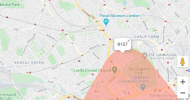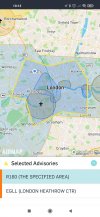I'm a new DJI mini 2 owner in London - looking forward to the freedom that 1st Jan should give us!
But, of course, we'll still have to fly safe and comply with all the restricted zones so I'm trying to understand them.
Specifically I'm trying to work out if I can fly in my garden (with neighbors on side) which is in Kilburn, Zone 2 NW, London.
More generally, how do I interpret the zones on the different info sources.
So first the DJI app. It warns me I'm in Class D airspace but once I accept the warning it'll let me fly here.
Then I've checked NoFlyDrones.co.uk
That shows the restricted zone R157 which covers central London but I'm outside that.

It shows no restrictions where I am - so that looks like good news.
Then if I check the NATS Drone Assist App it shows the same R157 zone which I'm not in.
But it also shows a larger restricted area which it simply calls The Specified Area.
It says "the flight of aircraft within this area is restricted. We recommend you do not operate your drone here. If you do, please exercise extreme caution and abide by the CAA Dronecode".
It also shows the very large London CTR which again recommends extreme caution.
So that seems to be saying I can fly here but to be very careful.
Then I checked the Airmap App.
That labels the area I'm in as R160 (The Specified Area) but gives no details of what it means (or if it does I can't find it).

Lastly I check the dronescene.co.uk website.
That also has me in a restricted area and says this:
Category
Restricted Area
Summary
Red zones are regulated high-risk areas and operation of your drone may be hazardous or prohibited.
Restricted Area
The flight of aircraft within this area is restricted in accordance with certain specified conditions. Notes attached to this area provide additional information. Danger, Prohibited and Restricted Areas are defined according to ICAO International Standards. Regulations governing the flight of drones vary from country-to-country, therefore these areas are included for your information. It is your responsibility to check the applicability of any local, state and/or national laws and regulations which may permit or otherwise restrict the operation of your drone in this area. Unless regulations in your region explicitly permit the operation of your drone in this area, we recommend you do not operate your drone here.
So it's bloomin' confusing that some sources of info have me in a restricted area and others don't.
And I can't find anywhere what the actual rules for the R160 area are.
Can anyone help me out?
Will I be able to legally fly in my local area (after 1st Jan)?
And more generally, what's the simplest way to actually find out the situation in a specific area?
But, of course, we'll still have to fly safe and comply with all the restricted zones so I'm trying to understand them.
Specifically I'm trying to work out if I can fly in my garden (with neighbors on side) which is in Kilburn, Zone 2 NW, London.
More generally, how do I interpret the zones on the different info sources.
So first the DJI app. It warns me I'm in Class D airspace but once I accept the warning it'll let me fly here.
Then I've checked NoFlyDrones.co.uk
That shows the restricted zone R157 which covers central London but I'm outside that.

It shows no restrictions where I am - so that looks like good news.
Then if I check the NATS Drone Assist App it shows the same R157 zone which I'm not in.
But it also shows a larger restricted area which it simply calls The Specified Area.
It says "the flight of aircraft within this area is restricted. We recommend you do not operate your drone here. If you do, please exercise extreme caution and abide by the CAA Dronecode".
It also shows the very large London CTR which again recommends extreme caution.
So that seems to be saying I can fly here but to be very careful.
Then I checked the Airmap App.
That labels the area I'm in as R160 (The Specified Area) but gives no details of what it means (or if it does I can't find it).

Lastly I check the dronescene.co.uk website.
That also has me in a restricted area and says this:
Category
Restricted Area
Summary
Red zones are regulated high-risk areas and operation of your drone may be hazardous or prohibited.
Restricted Area
The flight of aircraft within this area is restricted in accordance with certain specified conditions. Notes attached to this area provide additional information. Danger, Prohibited and Restricted Areas are defined according to ICAO International Standards. Regulations governing the flight of drones vary from country-to-country, therefore these areas are included for your information. It is your responsibility to check the applicability of any local, state and/or national laws and regulations which may permit or otherwise restrict the operation of your drone in this area. Unless regulations in your region explicitly permit the operation of your drone in this area, we recommend you do not operate your drone here.
So it's bloomin' confusing that some sources of info have me in a restricted area and others don't.
And I can't find anywhere what the actual rules for the R160 area are.
Can anyone help me out?
Will I be able to legally fly in my local area (after 1st Jan)?
And more generally, what's the simplest way to actually find out the situation in a specific area?











